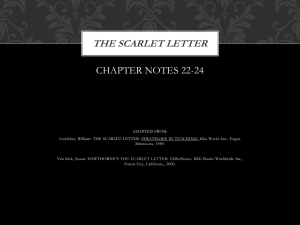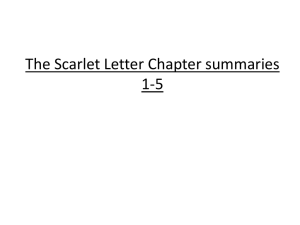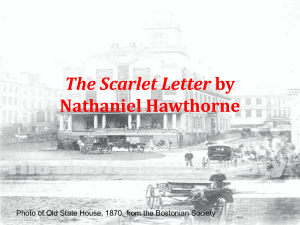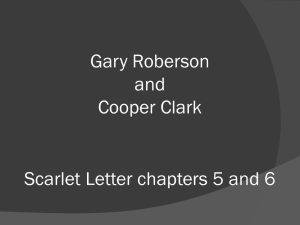literary analysis data sheet
advertisement
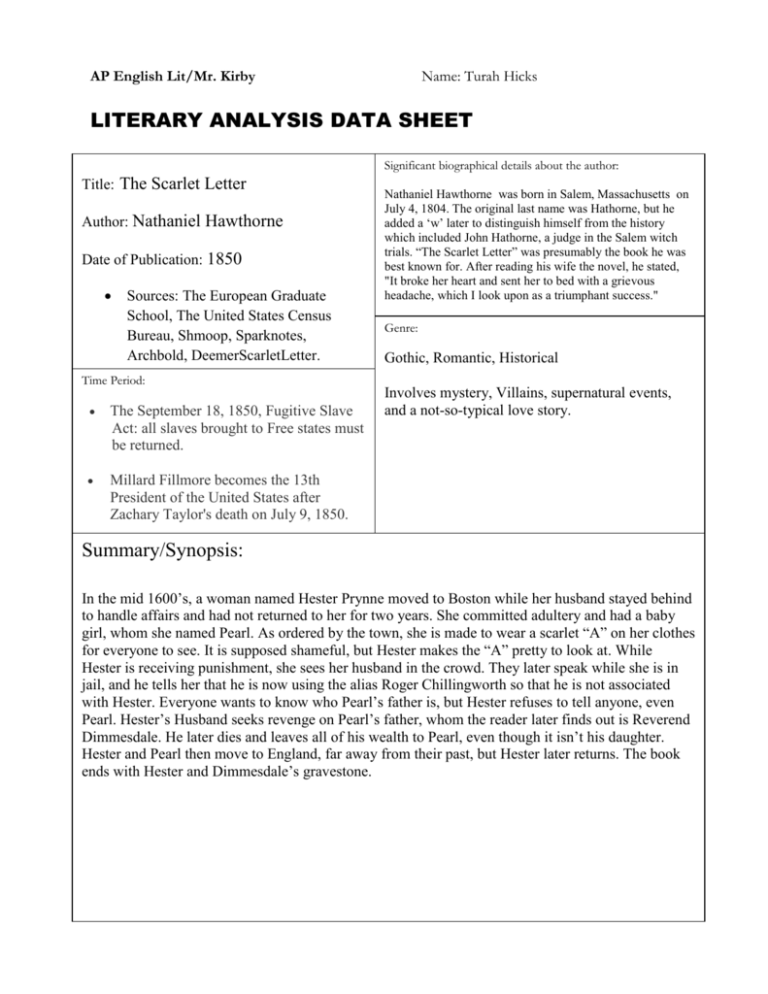
AP English Lit/Mr. Kirby Name: Turah Hicks LITERARY ANALYSIS DATA SHEET Significant biographical details about the author: Title: The Scarlet Letter Author: Nathaniel Hawthorne Date of Publication: 1850 Sources: The European Graduate School, The United States Census Bureau, Shmoop, Sparknotes, Archbold, DeemerScarletLetter. Time Period: The September 18, 1850, Fugitive Slave Act: all slaves brought to Free states must be returned. Millard Fillmore becomes the 13th President of the United States after Zachary Taylor's death on July 9, 1850. Nathaniel Hawthorne was born in Salem, Massachusetts on July 4, 1804. The original last name was Hathorne, but he added a ‘w’ later to distinguish himself from the history which included John Hathorne, a judge in the Salem witch trials. “The Scarlet Letter” was presumably the book he was best known for. After reading his wife the novel, he stated, "It broke her heart and sent her to bed with a grievous headache, which I look upon as a triumphant success." Genre: Gothic, Romantic, Historical Involves mystery, Villains, supernatural events, and a not-so-typical love story. Summary/Synopsis: In the mid 1600’s, a woman named Hester Prynne moved to Boston while her husband stayed behind to handle affairs and had not returned to her for two years. She committed adultery and had a baby girl, whom she named Pearl. As ordered by the town, she is made to wear a scarlet “A” on her clothes for everyone to see. It is supposed shameful, but Hester makes the “A” pretty to look at. While Hester is receiving punishment, she sees her husband in the crowd. They later speak while she is in jail, and he tells her that he is now using the alias Roger Chillingworth so that he is not associated with Hester. Everyone wants to know who Pearl’s father is, but Hester refuses to tell anyone, even Pearl. Hester’s Husband seeks revenge on Pearl’s father, whom the reader later finds out is Reverend Dimmesdale. He later dies and leaves all of his wealth to Pearl, even though it isn’t his daughter. Hester and Pearl then move to England, far away from their past, but Hester later returns. The book ends with Hester and Dimmesdale’s gravestone. Literary Analysis Data Sheet page 2 Literary Techniques: Examples: Allegory- Gives Characters deeper symbolic meanings; Hester-Shame, Letter A-Sin "Hester, though he were to step down from a high place, and stand there beside thee, on thy pedestal of shame, yet better were it so, than to hide a guilty heart through life." Foreshadowing-Hester and Pearl stand on the scaffold together Satire-Old women of the town want her branded with the letter A as punishment “Not so, my child. I shall, indeed, stand with thy mother and thee one other day, but not tomorrow.” “The ladies are called church members in good repute… They want to put a brand of hot iron on Hester's forehead.” Significant Quotes “Mother,” said little Pearl, “the sunshine does not love you. It runs away and hides itself, because it is afraid of something on your bosom. . . . It will not flee from me, for I wear nothing on my bosom yet!” “Nor ever will, my child, I hope,” said Hester. “And why not, mother?” asked Pearl, stopping short. . . . “Will it not come of its own accord, when I am a woman grown?” Pearl identifies the scarlet letter on her mother’s bosom with the metaphorical lack of sunshine in her mother’s life. Here Pearl is assuming that her mother is representative of all adults and all adults wear a scarlet letter. “Mother,” said [Pearl], “was that the same minister that kissed me by the brook?” “Hold thy peace, dear little Pearl!” whispered her mother. “We must not always talk in the market-place of what happens to us in the forest.” This conversation takes place a few days after Hester and Pearl’s encounter with Dimmesdale in the forest. Hester wishes Pearl to not reveal her mother’s secret plan to flee. Hester’s statement suggests that plans made in the forest are forbidden. What is possible in the woods is not an option in the heart of the Puritan town. “Here had been her sin; here, her sorrow; and here was yet to be her penitence. She had returned, therefore, and resumed,—of her own free will, for not the sternest magistrate of that iron period would have imposed it,— resumed the symbol of which we have related so dark a tale. Never afterwards did it quit her bosom. But . . . the scarlet letter ceased to be a stigma which attracted the world’s scorn and bitterness, and became a type of something to be sorrowed over, and looked upon with awe, and yet with reverence, too.” After many years, Hester returned to her former home. She resumes wearing the scarlet letter because her past is an part of her identity and cannot be changed just because someone declared it shameful. She creates a life in which the scarlet letter is not a sign of failure or condemnation. She is not the example of sin that she was once intended to be. Rather, she is an example of redemption. Literary Analysis Data Sheet page 3 Characters Name Role in the story Hester Prynne Main Character Roger Chillingworth Hester’s Husband Arthur Dimmesdale Pearl’s father and the man Hester commited adultery with Pearl Hester and Dimesdale’s daughter Significance or Purpose Adjectives Commits adultery and is forced to wear a red letter “A” on her clothing for the rest of her life as punishment. Shameful, sinful, guilty, contemplative, compassionate Furious with the affair his wife had, seeks revenge on the other man. Cold-hearted, twisted, careless, distorted Hester takes all of the blame for the affair and doesn’t tell anyone who she had the affair with. He becomes a great leader in the novel but is guilty on the inside. Guilty, caring, strong, empathetic More perceptive of the truth in the world than many of the adults. She doesn’t find out Dimmesdale is her father until much later Innocent, intuitive, wise, caring Literary Analysis Data Sheet page 4 Setting: Themes: Mid-17th century New England (Boston, Massachusetts Bay Colony) Sin and knowledge are two major themes. For Hester, the scarlet letter is her punishment for adultery, which is a sin. As for Dimmesdale, the “burden” of his sin gives him “sympathies so intimate with the sinful brotherhood of mankind, so that his heart vibrate[s] in unison with theirs.” Sin is a threat to the puritan community that should be punished and suppressed. This community was specifically designed to be religiously pure, which means being secularly strict. This explains Hester’s punishment. Symbols: Pearl serves as the proof of a sin that was committed by Hester, but Hester sees Pearl as more of a prize than a price. The Scarlet Letter ‘A” is the mark of sin on Hester for committing adultery, but she later views it as a mark of her identity that makes her an individual who is only human. The forest is unknown to the townspeople and offers a sanctuary of some sort to Hester and Pearl. The forest is without laws and criticizing eyes of the town. Identity and society are two more major themes. Hester returns to her hometown after moving far away to relieve the turmoil she endured while wearing the scarlet letter. She realizes that it was a part of her identity and she could only embrace it rather than try to act like it never happened. To her, running away or removing the letter would be an acknowledgment of society’s power over her: she would be admitting that the letter is a mark of shame. Discussion Questions: 1. If Hester Prynne could have changed one thing about Puritan society, what do you think it would have been? 2. Is religion ultimately depicted as a positive or a negative force in the novel? Who does it particularly seem to benefit? 3. Why did Hester leave her hometown then return? What was her reasoning for accepting her past?

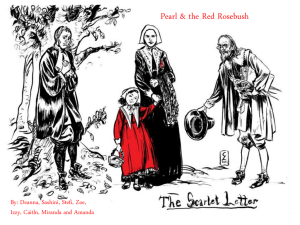
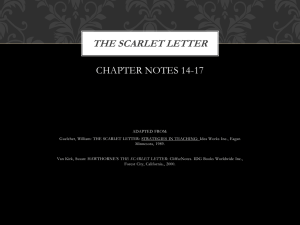
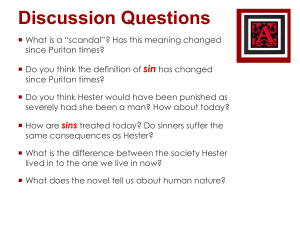
![Scarlet Letter[1]](http://s2.studylib.net/store/data/005409708_1-3646d9c34140ccf13fe9da17d2884083-300x300.png)
